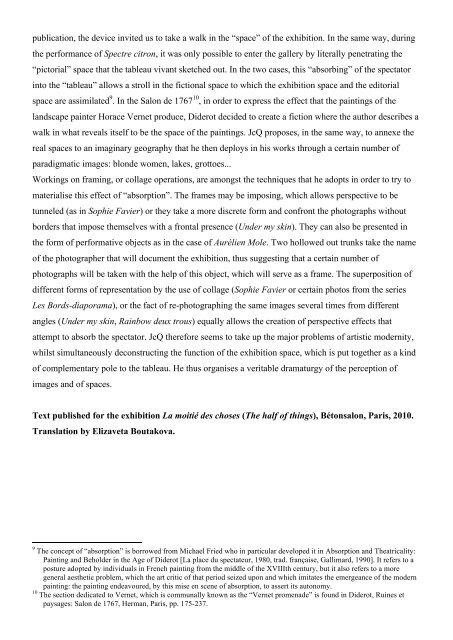« J'ai longtemps habité sous de vastes portiques Que les soleils ...
« J'ai longtemps habité sous de vastes portiques Que les soleils ...
« J'ai longtemps habité sous de vastes portiques Que les soleils ...
Create successful ePaper yourself
Turn your PDF publications into a flip-book with our unique Google optimized e-Paper software.
publication, the <strong>de</strong>vice invited us to take a walk in the “space” of the exhibition. In the same way, during<br />
the performance of Spectre citron, it was only possible to enter the gallery by literally penetrating the<br />
“pictorial” space that the tableau vivant sketched out. In the two cases, this “absorbing” of the spectator<br />
into the “tableau” allows a stroll in the fictional space to which the exhibition space and the editorial<br />
space are assimilated 9 . In the Salon <strong>de</strong> 1767 10 , in or<strong>de</strong>r to express the effect that the paintings of the<br />
landscape painter Horace Vernet produce, Di<strong>de</strong>rot <strong>de</strong>ci<strong>de</strong>d to create a fiction where the author <strong>de</strong>scribes a<br />
walk in what reveals itself to be the space of the paintings. JcQ proposes, in the same way, to annexe the<br />
real spaces to an imaginary geography that he then <strong>de</strong>ploys in his works through a certain number of<br />
paradigmatic images: blon<strong>de</strong> women, lakes, grottoes...<br />
Workings on framing, or collage operations, are amongst the techniques that he adopts in or<strong>de</strong>r to try to<br />
materialise this effect of “absorption”. The frames may be imposing, which allows perspective to be<br />
tunneled (as in Sophie Favier) or they take a more discrete form and confront the photographs without<br />
bor<strong>de</strong>rs that impose themselves with a frontal presence (Un<strong>de</strong>r my skin). They can also be presented in<br />
the form of performative objects as in the case of Aurélien Mole. Two hollowed out trunks take the name<br />
of the photographer that will document the exhibition, thus suggesting that a certain number of<br />
photographs will be taken with the help of this object, which will serve as a frame. The superposition of<br />
different forms of representation by the use of collage (Sophie Favier or certain photos from the series<br />
Les Bords-diaporama), or the fact of re-photographing the same images several times from different<br />
ang<strong>les</strong> (Un<strong>de</strong>r my skin, Rainbow <strong>de</strong>ux trous) equally allows the creation of perspective effects that<br />
attempt to absorb the spectator. JcQ therefore seems to take up the major problems of artistic mo<strong>de</strong>rnity,<br />
whilst simultaneously <strong>de</strong>constructing the function of the exhibition space, which is put together as a kind<br />
of complementary pole to the tableau. He thus organises a veritable dramaturgy of the perception of<br />
images and of spaces.<br />
Text published for the exhibition La moitié <strong>de</strong>s choses (The half of things), Bétonsalon, Paris, 2010.<br />
Translation by Elizaveta Boutakova.<br />
9 The concept of “absorption” is borrowed from Michael Fried who in particular <strong>de</strong>veloped it in Absorption and Theatricality:<br />
Painting and Behol<strong>de</strong>r in the Age of Di<strong>de</strong>rot [La place du spectateur, 1980, trad. française, Gallimard, 1990]. It refers to a<br />
posture adopted by individuals in French painting from the middle of the XVIIIth century, but it also refers to a more<br />
general aesthetic problem, which the art critic of that period seized upon and which imitates the emergeance of the mo<strong>de</strong>rn<br />
painting: the painting en<strong>de</strong>avoured, by this mise en scene of absorption, to assert its autonomy.<br />
10 The section <strong>de</strong>dicated to Vernet, which is communally known as the “Vernet promena<strong>de</strong>” is found in Di<strong>de</strong>rot, Ruines et<br />
paysages: Salon <strong>de</strong> 1767, Herman, Paris, pp. 175-237.



